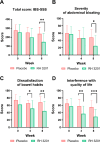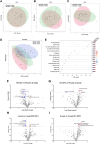Effect of Lacticaseibacillus rhamnosus IDCC 3201 on irritable bowel syndrome with constipation: a randomized, double-blind, and placebo-controlled trial
- PMID: 39333245
- PMCID: PMC11437119
- DOI: 10.1038/s41598-024-72887-x
Effect of Lacticaseibacillus rhamnosus IDCC 3201 on irritable bowel syndrome with constipation: a randomized, double-blind, and placebo-controlled trial
Abstract
Irritable bowel syndrome is a chronic disorder affecting the gastrointestinal tract, negatively impacting patients' quality of life. Here, we aimed to evaluate the effects of Lacticaseibacillus rhamnosus IDCC 3201 (RH 3201) on irritable bowel syndrome with constipation (IBS-C). In this randomised, double-blind, placebo-controlled trial, a total of 30 subjects with IBS-C were randomly assigned (1:1) to receive 8 weeks of probiotics administration or placebo. Concerning bowel activities, both irritant bowel movements and discomfort caused by constipation showed significant improvement with RH 3201 at 8 weeks. Symptoms including severity of abdominal bloating, frequency of abdominal bloating, and satisfaction of bowel habits based on the irritable bowel syndrome-severity scoring system also ameliorated in the probiotic group. Analysis of the fecal microbiome revealed that the abundance of Bacteroides cellulosilyticus and Akkermansia muciniphila was higher during the period of RH 3201 administration compared to the placebo. Untargeted metabolome analysis further suggested a correlation between specific metabolites, such as N-acetylornithine, xanthine, and 3-phenylpropionic acid, and the improvement of clinical symptoms. These results indicate that RH 3201 was effective in ameliorating IBS-C, potentially by enriching beneficial microbes and associated metabolites in the gut environment.
© 2024. The Author(s).
Conflict of interest statement
The authors declare no competing interests.
Figures








References
-
- Ahlawat, S. & Asha, Sharma, K. K. Gut-organ axis: a microbial outreach and networking. Lett. Appl. Microbiol. 72. 10.1111/lam.13333 (2021). - PubMed
Publication types
MeSH terms
Grants and funding
LinkOut - more resources
Full Text Sources
Medical

